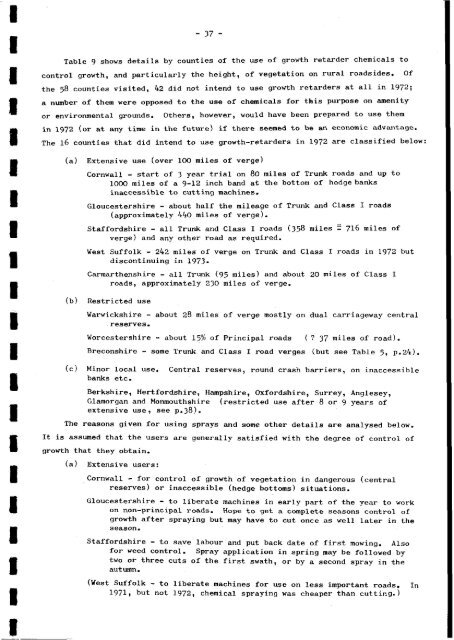road verges on rural roads - NERC Open Research Archive ...
road verges on rural roads - NERC Open Research Archive ...
road verges on rural roads - NERC Open Research Archive ...
You also want an ePaper? Increase the reach of your titles
YUMPU automatically turns print PDFs into web optimized ePapers that Google loves.
Table 9 shows details by counties of the use of growth retarder chemicals to<br />
c<strong>on</strong>trol growth, and particularly the height, of vegetati<strong>on</strong> <strong>on</strong> <strong>rural</strong> <str<strong>on</strong>g>road</str<strong>on</strong>g>sides. Of<br />
the 58 counties visited, 42 did not intend to use growth retarders at all in 1972;<br />
a number of them were opposed to the use of chemicals for this purpose <strong>on</strong> amenity<br />
or envir<strong>on</strong>mental grounds. Others, however, would have been prepared to use them<br />
in 1972 (or at any time in the future) if there seemed to be an ec<strong>on</strong>omic advantage.<br />
The 16 counties that did intend to use growth-retarders in 1972 are classified below:<br />
(a) Extensive use (over 100 miles of verge)<br />
Cornwall - start of 3 year trial <strong>on</strong> 80 miles of Trunk <str<strong>on</strong>g>road</str<strong>on</strong>g>s and up to<br />
1000 miles of a 9-12 inch band at the bottom of hedgebanks<br />
inaccessible to cutting machines.<br />
Gloucestershire - about half the mileage of Trunk and Class I <str<strong>on</strong>g>road</str<strong>on</strong>g>s<br />
(approximately 440 miles of verge).<br />
Staffordshire - all Trunk and Class I <str<strong>on</strong>g>road</str<strong>on</strong>g>s (358 miles 5 716 miles of<br />
verge) and any other <str<strong>on</strong>g>road</str<strong>on</strong>g> as required.<br />
West Suffolk - 242 miles of verge <strong>on</strong> Trunk and Class I <str<strong>on</strong>g>road</str<strong>on</strong>g>s in 1972 but<br />
disc<strong>on</strong>tinuing in 1973.<br />
Carmarthenshire - all Trunk (95 miles) and about 20 miles of Class I<br />
<str<strong>on</strong>g>road</str<strong>on</strong>g>s, approximately 230 miles of verge.<br />
(b) Restricted use<br />
Warwickshire - about 28 miles of verge mostly <strong>on</strong> dual carriageway central<br />
reserves.<br />
Worcestershire - about 15% of Principal <str<strong>on</strong>g>road</str<strong>on</strong>g>s (? 37 miles of <str<strong>on</strong>g>road</str<strong>on</strong>g>).<br />
Brec<strong>on</strong>shire - some Trunk and Class I <str<strong>on</strong>g>road</str<strong>on</strong>g> <str<strong>on</strong>g>verges</str<strong>on</strong>g> (but see Table 5, p.24).<br />
(c) Minor local use. Central reserves, round crash barriers, <strong>on</strong> inaccessible<br />
banks etc.<br />
Berkshire, Hertfordshire, Hampshire, Oxfordshire, Surrey, Anglesey,<br />
Glamorgan and M<strong>on</strong>mouthshire (restricted use after 8 or 9 years of<br />
extensive use, see p.38).<br />
The reas<strong>on</strong>s given for using sprays and some other details are analysed below.<br />
It is assumed that the users are generally satisfied with the degree of c<strong>on</strong>trol of<br />
growth that they obtain.<br />
(a) Extensive users:<br />
Cornwall - for c<strong>on</strong>trol of growth of vegetati<strong>on</strong> in dangerous (central<br />
reserves) or inaccessible (hedge bottoms) situati<strong>on</strong>s.<br />
Gloucestershire - to liberate machines in early part of the year to work<br />
<strong>on</strong> n<strong>on</strong>-principal <str<strong>on</strong>g>road</str<strong>on</strong>g>s. Hope to get a complete seas<strong>on</strong>s c<strong>on</strong>trol of<br />
growth after spraying but may have to cut <strong>on</strong>ce as well later in the<br />
seas<strong>on</strong>.<br />
Staffordshire - to save labour and put back date of first mowing. Also<br />
for weed c<strong>on</strong>trol. Spray applicati<strong>on</strong> in spring may be followed by<br />
two or three cuts of the first swath, or by a sec<strong>on</strong>d spray in the<br />
autumn.<br />
(West Suffolk - to liberate machines for use <strong>on</strong> less important <str<strong>on</strong>g>road</str<strong>on</strong>g>s. In<br />
1971, but not 1972, chemical spraying was cheaper than cutting-)

















